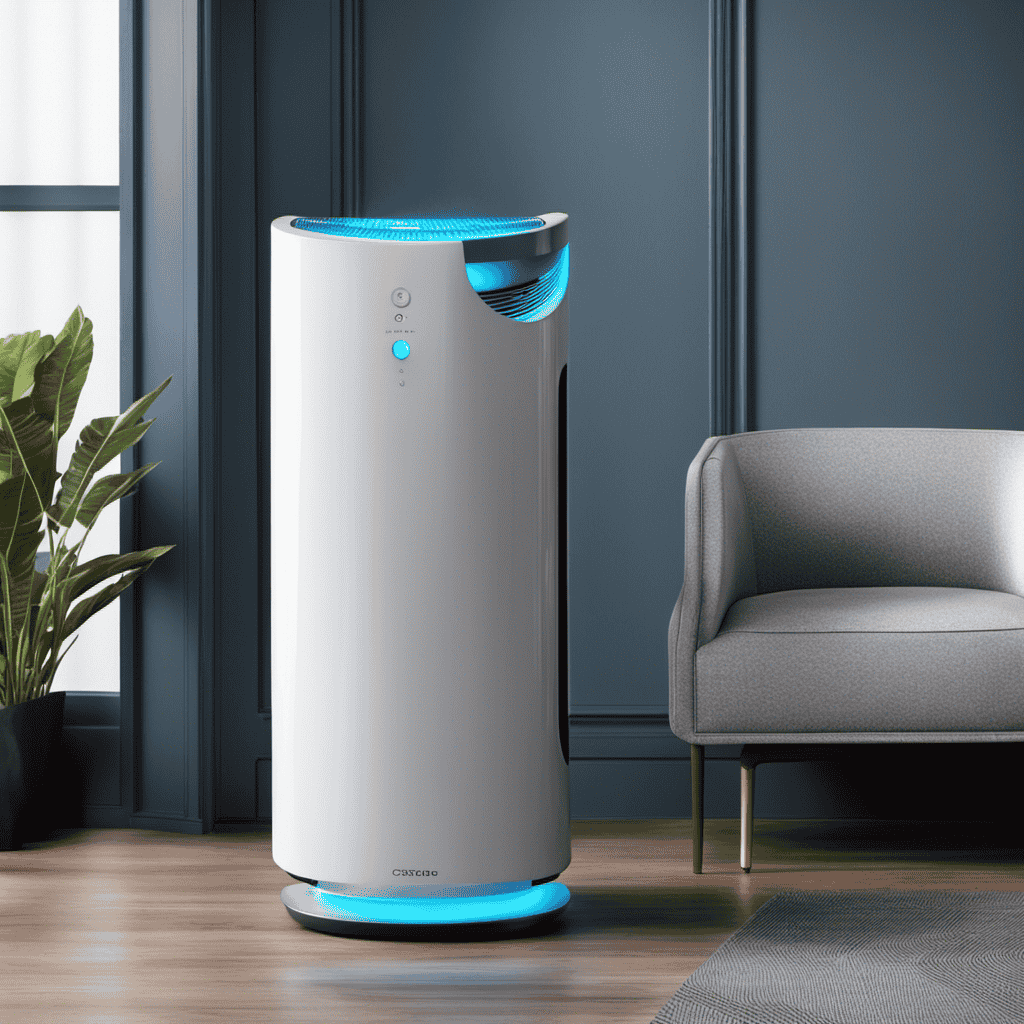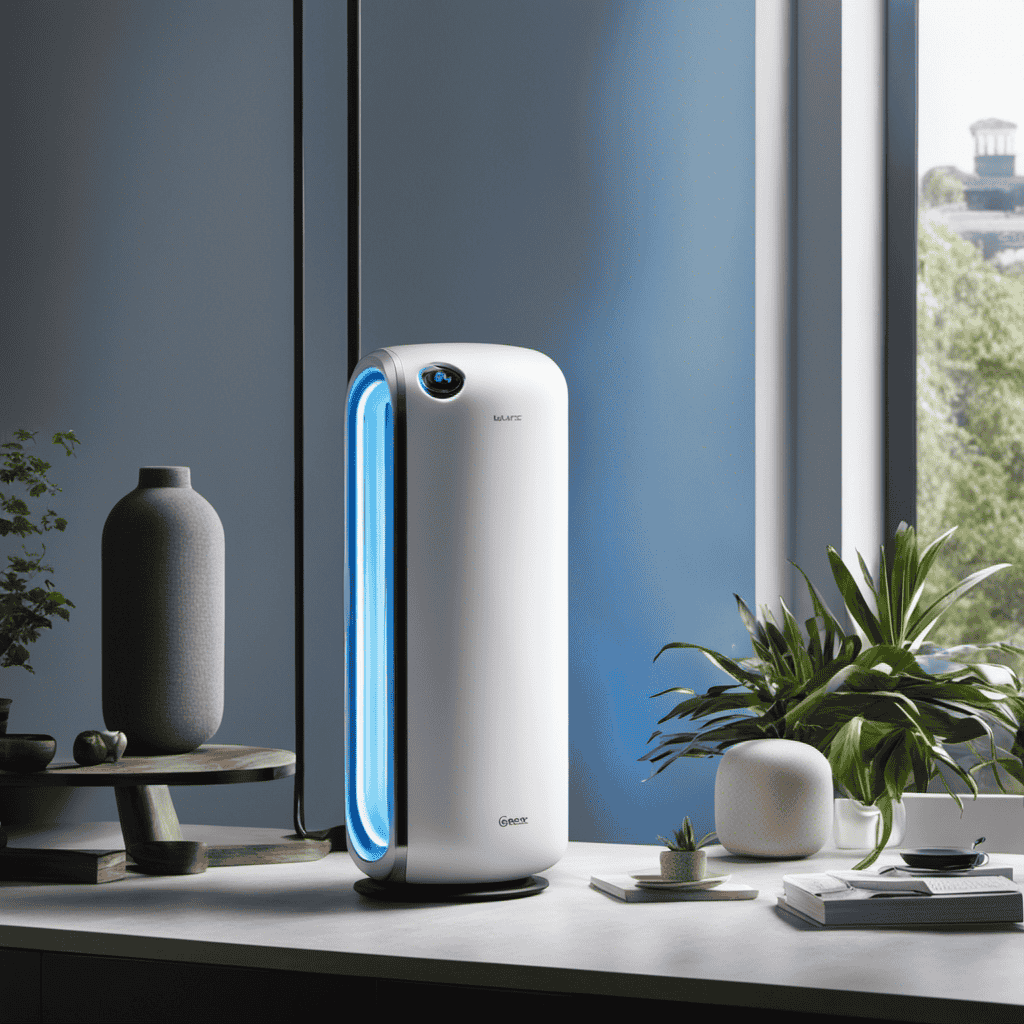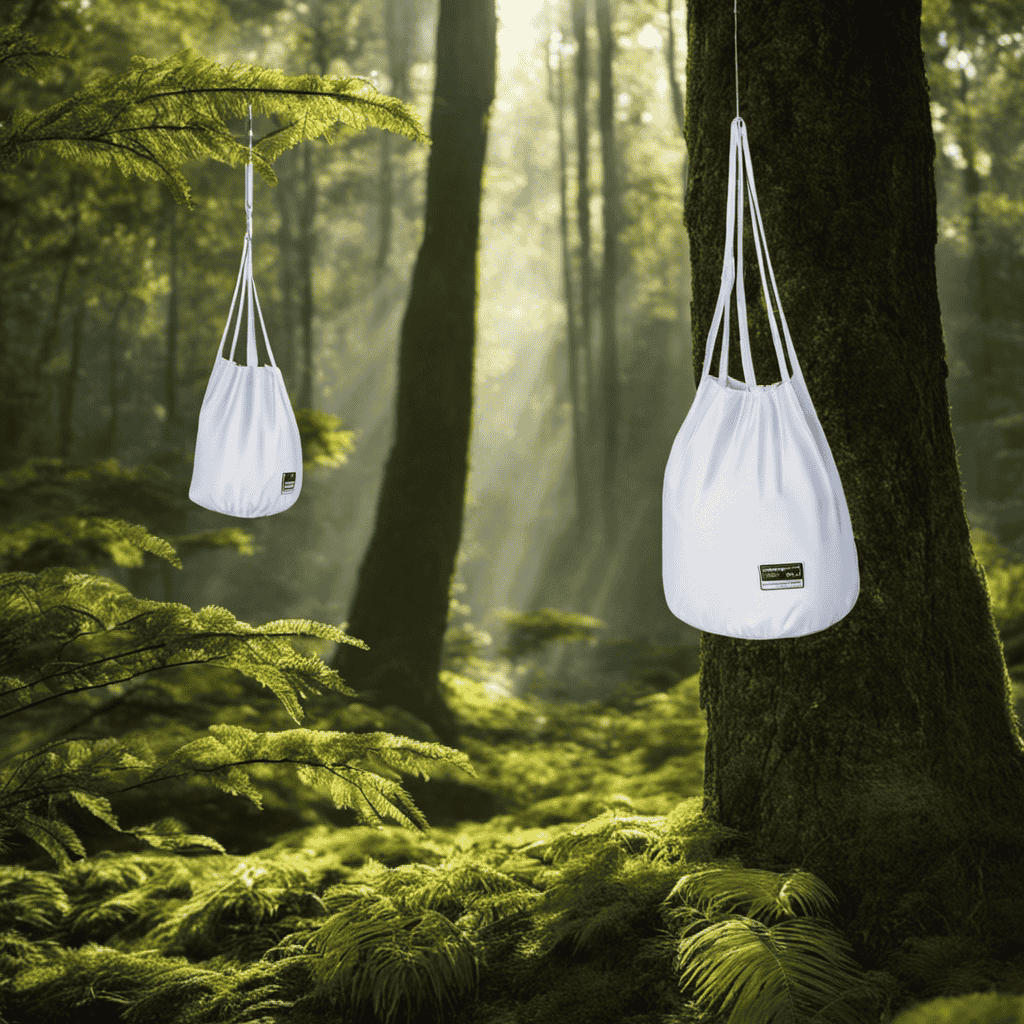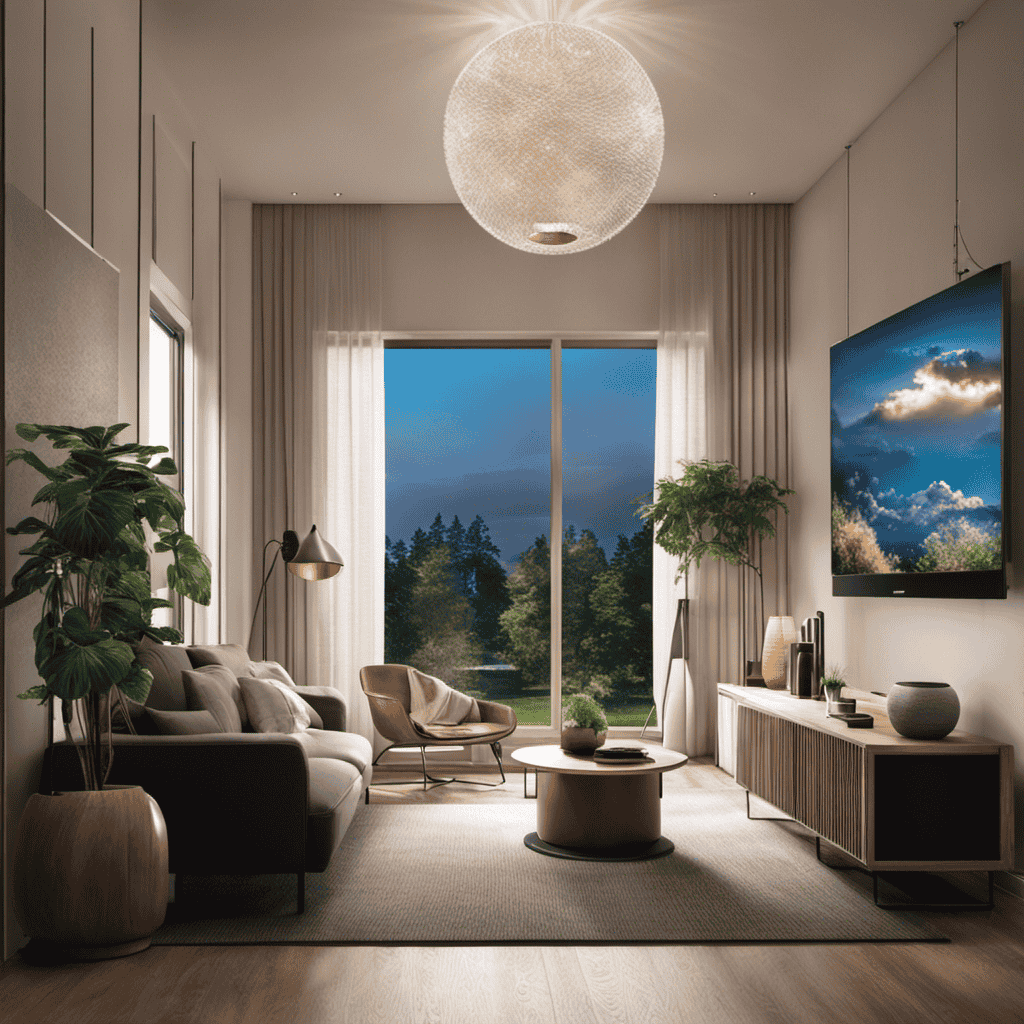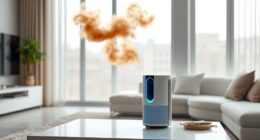As a passionate researcher and advocate for clean air, I have thoroughly explored the realm of air purifiers. One specific type that has intrigued me is the UV light air purifier. With its advanced technology and effectiveness in removing airborne pathogens, it’s clear why these devices are becoming increasingly popular.
In this article, we will explore the science behind UV light air purifiers, understand how they work, and uncover the benefits they offer compared to traditional purifiers.
So, let’s shine a light on UV air purification and breathe in the knowledge!
Key Takeaways
- UV-C light, with a wavelength of 254 nanometers, destroys the DNA and RNA of microorganisms.
- UV-C technology is widely used in hospitals, laboratories, and healthcare settings.
- UV-C light air purifiers are highly effective at killing airborne germs, such as bacteria and viruses.
- UV light air purifiers do not leave any residue or produce harmful by-products.
The Science Behind UV Light Air Purifiers
UV light air purifiers work by using ultraviolet light to kill germs and neutralize odors in the air. These purifiers are highly effective in providing airborne virus protection and are widely used in hospitals, laboratories, and other healthcare settings.
The effectiveness of UV light purification lies in its ability to destroy the DNA and RNA of microorganisms, rendering them unable to reproduce and causing their death. When air passes through the purifier, it is exposed to UV-C light, which has a wavelength of 254 nanometers. This specific wavelength is known to be germicidal, meaning it can inactivate viruses, bacteria, and other harmful microorganisms.
Understanding UV-C Technology for Air Purification
Understanding how UV-C technology works is crucial for effective air purification. UV-C light technology is a powerful tool in the fight against airborne pathogens and allergens. Here’s how it works:
-
Ultraviolet Germicidal Irradiation (UVGI): UV-C light, with a wavelength between 200-280 nanometers, damages the DNA and RNA of microorganisms, rendering them unable to reproduce or causing their death.
-
Airborne Disinfection: UV-C light air purifiers use fans to draw in contaminated air and expose it to UV-C light. This kills or inactivates bacteria, viruses, and mold spores, making the air cleaner and safer to breathe.
-
Effectiveness: UV-C light technology has been proven effective in reducing the spread of airborne diseases, such as tuberculosis and influenza. It also helps control allergens like pollen and pet dander.
How UV Light Kills Airborne Pathogens
UV-C technology utilizes its powerful wavelength to damage the DNA and RNA of microorganisms, rendering them unable to reproduce or causing their death. This method of disinfection is commonly used in healthcare settings due to its numerous benefits.
UV-C technology is highly effective in killing a wide range of airborne pathogens, including bacteria, viruses, and fungi. Unlike chemical disinfectants, UV-C light does not leave any residue or produce harmful by-products, making it a safe and environmentally friendly option.
Additionally, UV-C light can be used in conjunction with other disinfection methods, such as filtration systems, to provide a comprehensive approach to improving indoor air quality. Its ability to destroy microorganisms at the molecular level makes UV-C technology a valuable tool in healthcare facilities, helping to reduce the spread of infectious diseases and create a safer environment for patients and staff.
Benefits of Using UV Light Air Purifiers
Using UV light air purifiers has numerous benefits for improving indoor air quality.
Firstly, these purifiers are highly effective at killing airborne germs, such as bacteria and viruses, due to their ability to disrupt the DNA structure of these pathogens.
Additionally, UV light air purifiers can also reduce allergens and odors in the air by neutralizing and breaking down these particles, making them less likely to cause allergic reactions or unpleasant smells.
Overall, incorporating UV light air purifiers into your indoor environment can significantly enhance the quality of the air you breathe.
Kills Airborne Germs
To effectively kill airborne germs, you’ll need to ensure that the UV light air purifier is properly maintained and the UV-C bulbs are regularly replaced. UV light air purifiers are an effective tool in providing airborne virus protection and UV air sterilization. Here are three key reasons why UV light air purifiers are essential for killing airborne germs:
-
Powerful Germicidal Action: UV-C bulbs emit ultraviolet light that has germicidal properties. When the air passes through the purifier, the UV light kills viruses, bacteria, and other harmful microorganisms.
-
Continuous Air Disinfection: Unlike traditional air purifiers that filter out particles, UV light air purifiers actively disinfect the air by continuously emitting UV light. This ensures that any airborne germs are effectively neutralized.
-
Improved Indoor Air Quality: By killing airborne germs, UV light air purifiers help improve indoor air quality and reduce the risk of infections. This is particularly important in spaces where individuals with weakened immune systems or respiratory conditions spend a lot of time.
Regular maintenance and replacement of UV-C bulbs are crucial to ensure the maximum effectiveness of the UV light air purifier in killing airborne germs and providing optimal airborne virus protection and UV air sterilization.
Reduces Allergens and Odors
If you’re looking to reduce allergens and odors in your space, regular use of this device will greatly improve the air quality. UV light air purifiers are designed to target and eliminate various pollutants, including pet dander and smoke particles.
Pet dander, which consists of tiny flakes of skin shed by animals, can trigger allergic reactions in sensitive individuals. UV light air purifiers use ultraviolet light to deactivate the DNA of these microscopic particles, rendering them harmless.
Additionally, these devices are effective in eliminating smoke particles from the air. Smoke particles, whether from cigarettes or cooking, can linger in the environment and cause respiratory problems. The UV light in air purifiers breaks down the chemical compounds present in smoke particles, neutralizing their harmful effects.
Improves Indoor Air Quality
Regular use of this device greatly improves the air quality indoors. As a user, I’ve experienced the benefits of an air purifier equipped with UV light technology firsthand. Here are three reasons why this device is a game-changer:
-
Eliminates airborne viruses and bacteria: The UV light technology in air purifiers effectively kills harmful microorganisms, reducing the risk of respiratory infections and illnesses.
-
Removes allergens and pollutants: Air purifiers with UV light can eliminate common allergens like pollen, dust mites, and pet dander, providing relief to those with allergies or asthma.
-
Neutralizes odors and chemicals: UV light can break down volatile organic compounds (VOCs) and eliminate unpleasant odors, creating a fresher and more inviting indoor environment.
Research has shown that UV light air purifiers are highly effective in improving indoor air quality. By investing in this technology, you can ensure a healthier and cleaner living space for you and your loved ones.
UV Light Air Purifiers Vs. Traditional Air Purifiers
When it comes to UV light air purifiers, you’ll find that they are more effective at eliminating harmful bacteria and viruses compared to traditional air purifiers. UV light in air purification works by emitting ultraviolet radiation that damages the DNA and RNA of microorganisms, rendering them unable to reproduce and causing them to die off. This makes UV light air purifiers highly effective in reducing the risk of airborne infections and improving indoor air quality. To better understand the difference between UV light air purifiers and traditional filters, let’s compare them in the table below:
| UV Light Air Purifiers | Traditional Air Purifiers |
|---|---|
| Effectiveness in eliminating bacteria and viruses | Less effective in eliminating bacteria and viruses |
| Continuous purification | Requires regular filter replacement |
| No ozone emissions | May produce ozone as a byproduct |
| Can be used in conjunction with other filtration methods | Standalone filtration system |
As you can see, UV light air purifiers have distinct advantages over traditional air purifiers when it comes to eliminating harmful microorganisms. Now that we understand the effectiveness of UV light in air purification, let’s explore the factors to consider when choosing a UV light air purifier.
Factors to Consider When Choosing a UV Light Air Purifier
When it comes to choosing a UV light air purifier, there are several factors to consider. These factors will help you make an informed decision and ensure that you get the most out of your investment.
Here are three key factors to consider:
-
Room Size: Determine the square footage of the room you want to purify. This will help you choose the right size and capacity of the UV light air purifier.
-
Filter Efficiency: Look for a UV light air purifier that has a high-efficiency particulate air (HEPA) filter. This type of filter can capture particles as small as 0.3 microns, including dust, pollen, pet dander, and mold spores.
-
Additional Features: Consider additional features such as multiple fan speeds, air quality sensors, and programmable timers. These features can enhance the performance and convenience of your UV light air purifier.
Benefits of UV light air purifiers include eliminating airborne pathogens, reducing allergies, and improving overall air quality. By considering these factors, you can choose the right UV light air purifier for your needs and enjoy the benefits it brings.
Common Misconceptions About UV Light Air Purifiers
One common misconception about UV light air purifiers is that they only eliminate germs and bacteria. But they can actually help reduce allergens as well. UV light air purifiers use ultraviolet (UV) radiation to kill microorganisms like bacteria, viruses, and mold spores.
However, they can also be effective in reducing airborne allergens such as pollen, pet dander, and dust mites. UV light air purifiers work by emitting UV-C radiation, which damages the DNA and RNA of microorganisms, rendering them unable to reproduce and causing them to die.
This same process can also help inactivating allergens by breaking down their proteins. It is important to note that while UV light air purifiers can be effective in reducing allergens, they should not be solely relied upon as a solution for allergies. Other measures like regular cleaning, proper ventilation, and maintaining a clean indoor environment are also essential.
Additionally, it is important to use UV light air purifiers safely, as prolonged exposure to UV-C radiation can pose potential health risks such as skin and eye damage.
Safety Precautions for Using UV Light Air Purifiers
It’s important to use UV light air purifiers safely to avoid potential health risks like skin and eye damage. Here are some safety precautions to keep in mind when using these devices:
-
Limit exposure: UV light can be harmful if you are directly exposed to it for prolonged periods. Make sure to minimize direct contact and avoid looking directly at the UV light source.
-
Use in empty rooms: UV light air purifiers work best in unoccupied spaces. It is advisable to operate them in empty rooms to prevent any accidental exposure to humans and pets.
-
Follow manufacturer’s instructions: Each UV light air purifier may have specific safety guidelines. It is crucial to carefully read and follow the manufacturer’s instructions to ensure safe usage.
By following these safety precautions, you can effectively enjoy the benefits of UV light air purifiers while minimizing any potential health risks.
Now, let’s move on to the next section, which discusses maintenance and cleaning tips for UV light air purifiers.
Maintenance and Cleaning Tips for UV Light Air Purifiers
To keep your UV light air purifier running effectively, make sure to regularly clean the filters and replace them as needed. Proper maintenance is crucial for ensuring the optimal performance of your air purifier and the quality of the air it provides.
When it comes to cleaning the filters, effective techniques include gently vacuuming them or rinsing them with water. It’s important to follow the manufacturer’s instructions to determine the appropriate cleaning method for your specific model.
Additionally, replacing the filters at the recommended intervals is essential to maintain the efficiency of your UV light air purifier.
Integrating UV Light Air Purifiers Into Your Home or Office Space
When integrating a UV light air purifier into your home or office space, you’ll want to consider the size of the area you’re looking to purify and choose a model that can effectively cover that space. Here are some best practices for integrating UV light air purifiers in different spaces:
-
Determine the square footage: Measure the size of the room or space you want to purify to ensure you select a UV light air purifier with the appropriate coverage.
-
Placement: Install the air purifier in a central location within the room for optimal airflow and maximum purification.
-
Maintenance and cleaning: Regularly clean the UV light air purifier’s filters and replace them as recommended by the manufacturer to ensure its efficiency and effectiveness.
Considering the cost effectiveness of UV light air purifiers, it is important to evaluate the initial purchase cost, as well as the long-term costs of replacement filters and energy consumption.
Frequently Asked Questions
Can UV Light Air Purifiers Be Used in All Types of Spaces, Such as Homes, Offices, and Hospitals?
UV light air purifiers can be effective in reducing the spread of viruses and bacteria in homes, offices, and hospitals. However, it is important to consider the pros and cons of their use in each environment, as effectiveness may vary.
How Long Does It Take for UV Light to Effectively Kill Airborne Pathogens?
It typically takes around 10 to 20 seconds for UV light to effectively kill airborne pathogens. However, the effectiveness of UV light can vary depending on factors such as the type of pathogen and the intensity of the light.
Are UV Light Air Purifiers Safe for Use Around Children and Pets?
UV light air purifiers are generally safe for use around children and pets. However, prolonged exposure to UV light may pose potential health risks, such as skin and eye damage. It is important to follow manufacturer guidelines for safe usage.
Can UV Light Air Purifiers Eliminate Odors in Addition to Killing Airborne Pathogens?
Yes, UV light air purifiers can eliminate odors in addition to killing airborne pathogens. They are effective in reducing allergens and are comparable to other air purification technologies in terms of their capabilities.
Do UV Light Air Purifiers Require Any Special Maintenance or Cleaning Procedures?
Maintaining and cleaning UV light air purifiers is crucial for optimal performance. Regularly replacing the UV lamps, cleaning the filters, and wiping down the unit with a damp cloth helps ensure efficiency and prolongs the lifespan of the purifier.
Conclusion
In conclusion, after extensive research and analysis, it is clear that UV light air purifiers are a game-changer in the world of air purification.
These innovative devices utilize UV-C technology to effectively eliminate airborne pathogens, providing cleaner and healthier indoor environments.
By harnessing the power of ultraviolet light, these purifiers offer numerous benefits over traditional air purifiers, making them a wise investment for any home or office space.
However, it is important to note that proper safety precautions and regular maintenance are crucial for optimal performance.
Integrating a UV light air purifier into your space can provide a breath of fresh air, metaphorically and literally.
